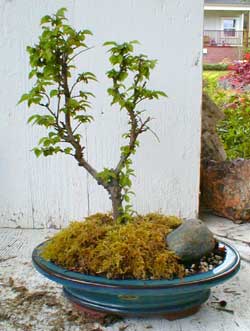
'Jacqueline Hillier' Dwarf Elm
"O, elm-leaves dark & dewy,
The very same ye seem,
The low wind trembles through ye,
Ye murmur in my dream!"
-James Russell Lowell
(1819-1891)
(1819-1891)
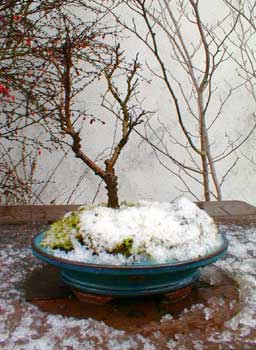 Ulmus x hollandica 'Jacqueline Hillier' was formerly called Ulmus x elegantissima 'Jacqueline Hillier,' & still commonly sold by that name. Because of a long period of uncertainty about its parentage, it is still sometimes sold as U. minor or the synonymous U. carpinifolia.
Ulmus x hollandica 'Jacqueline Hillier' was formerly called Ulmus x elegantissima 'Jacqueline Hillier,' & still commonly sold by that name. Because of a long period of uncertainty about its parentage, it is still sometimes sold as U. minor or the synonymous U. carpinifolia.It was discovered in a garden in Birmingham, England, as a spontaneous hybrid of U. glabra & U. plottii. Some have been more convinced it is a cross between U. glabra & U. minor. But the Birmingham garden where it first appeared was well within the natural range of U. plottii, so the Royal Horticultural Society seems now convinced it is half U. plottii. As often happens with such hybrids, it is even hardier than hardy elms.
'Jacquelline Hillier' is a beautiful dwarf elm that can be grown in the garden as a shrub or dwarf tree, or in containers, or as bonsai. Because the leaves are micro versions of a full-sized elm, it is a particularly good visual choice for bonsai, as it can truly look like a miniature of a gigantic elm. It is a good beginner's choice for bonsai since it can look like a well-trained tree even while very young, & it can withstand a lot of training even when someone starting out accidentally stresses the plant more than would a bonsai hobbyist with many years of expertise.
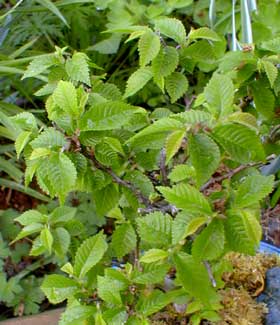 They are sometimes acclimated as indoor bonsai & will remain evergreen throughout the year if they do not experience winters, something most temperate bonsai trees would never adjust to.
They are sometimes acclimated as indoor bonsai & will remain evergreen throughout the year if they do not experience winters, something most temperate bonsai trees would never adjust to.A bonsai always raised indoors might not re-adjust to outdoor life. They are otherwise very winter-hardy to minus ten degrees F. or even colder, & go through all the expected seasonal changes of a temperate deciduous tree, though holding their tiny leaves until the start of winter, growing them back come April.
For indoor care they should never be allowed to dry out. Check the soil daily to make sure it remains moderately moist -- but never wet or rootrot could kill the little thing. It will also require misting once or twice a day. Outdoors it needs protection only from the coldest winter winds & placement where rain can reach it.
For spring through autumn it should never dry out entirely. It may shed its leaves in summer if drought-stressed, but is apt to recover by autumn if belatedly tended to. It will be at particular risk in summer because it does want a lot of sun but does not want its roots totally dried out. This can make it hard to leave bonsai elms unattended for a summer vacation, for a week ignored could dry out their shallow containers entirely.
Drip watering systems that make it possible to tend them less religiously will have to be carefully adjusted since too much moisture will rot them, & ideally the bonsai artist tests the soil or compost each day by touch before deciding it needs re-moistening.
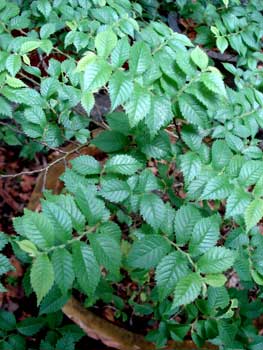 In a low-humidity summer they may need watering more than once a day. There are some bonsai choices, including many conifers, that can dry out for brief periods between watering, but elms would be stressed.
In a low-humidity summer they may need watering more than once a day. There are some bonsai choices, including many conifers, that can dry out for brief periods between watering, but elms would be stressed.The adult size of 'Jacqueline Hillier,' if not bonsaied, is six feet tall & wide in ten years, rounded with dense upright branchings, commonly aging with a flattening canopy.
If never pruned & restrained, it will become quite large over a great length of time, adding as much as four inches a year. As a shrub never trained for any particular effect, it can resemble an escalonia more than an elm, but can be trained as a garden or container plant to show its trunk & minimalize the busy-ness of its branches, so as to look like a six foot version of a giant elm.
Just about any elm can be given a bonsai treatment with complete success, even if not naturally a dwarf, 'Jacqueline Hillier' being already small takes to bonsai best of all. Its leaves are naturally pinky-fingernail sized if allowed to grow untrained, but with the bonsai treatment the leaves are truly dollhouse miniatures, as little as a baby's fingernail. They are otherwise just like a big elm's leaves, serated oblong with points, & a pleated herring-bone pattern; these leaves are so darned cute it makes my toes curl to gaze upon them.
I took notes on its care as a bonsai for my own reference, & here share the notes with others. The following advice was jotted down at the start of my own incursions into the hobby, which began with this specimen, given to me as a holiday gift from a good friend.
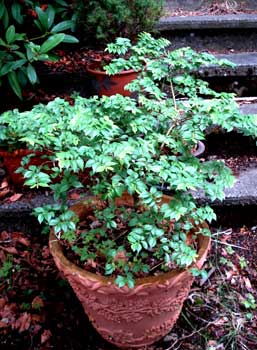 Since bonsai is so interpretative & success embodies many subtleties that I cannot as yet claim to possess, these notes should not be taken too strongly as definitive, but do attempt to be specific to this elm:
Since bonsai is so interpretative & success embodies many subtleties that I cannot as yet claim to possess, these notes should not be taken too strongly as definitive, but do attempt to be specific to this elm:As a garden shrub 'Jacqueline Hillier' Dwarf Elm requires little or no fertilizing, & too much nitrogen can in general stop elms from blooming. But bonsai has different criteria. To remain maximumly dwarfed, bonsai are pretty much starved for nutrients in the soil & not permitted room to develop large deep root systems. So that this does not result in actual ill health they are fed weekly beginning late winter & continuing until mid or late autumn.
When spring buds begin to open, it needs a high nitrogen feeding once a week for a month, tapering to high nitrogen every two weeks & a more balanced lowered-nitrogen feeding on alternating weeks until summer's end, & finally a balanced low-nitrogen feeding for all of autumn plus for indoor specimens all of winter.
As the tree develops under artful pruning, the trunk will gain in girth & the limbs will remain small with extremely thin limb ends. For pruning, allow a limb to reach outward to three our four nodes before trimming back to one or two nodes. Obviously one keeps only the limbs one envisions creating a specific desired naturalistic shape.
Minimal limbs can create an idealized form as in a Chinese painting or sumi brush strokes, this being called the lightning or literary form. It is also easily trained in the "broom" form which is more natural to its development.
For the minimalst-branching literary form, 'Jacqueline Hillier' does not invariably require a lot of wire training to have a naturally twisted look, but wire will control the shape more fully. Indoor plants are wired in summer; if defoliated for clearer view of the limbs being shaped, this is safely done mid to late summer. Outdoor specimens are more easily wire-trained in winter when there are no leaves to blur one's vision of how a limb should look.
Minor pruning or removal of tiny branches can be done at any time, but anything approaching a major cut will result in excess callousing if done in spring or summer. It should be done in late summer or autumn to minimalize the size of the scar.
Elms are propagated by numerous method, but this dwarf is best perpetuated from rooted cuttings. Hardwood cuttings are taken in winter & rooted with assistance of rooting hormone. Greenwood cuttings are taken in summer. Air-layering is done late in spring.
Happily, bonsai elms do not attract Dutch elm disease which requires a larger volume of wood to get established. They can however attract aphids & leafhoppers & are occasionally subject to gall mites, & when outdoors even a slug or snail could find their way to the elm's little tray.
Without regular attention to clipping new limbs or pinching buds, it can become quite thickly branched, & the minimal shallow-tray root system will not so easily support a densely branching compactly leafed elm. So if the amount of attention demanded is not the sort of hobby one is up for, a deeper container for a "normal" development might be preferred.
After my first two years with this little elm, I realized I was much to adjusted to naturalistic gardening where most things pretty much take care of themselves. The constant attention required to raise a bonsai had resulted in the little tree being at risk of death. So I transferred the elm to a large pot, & stopped trimming it as a minimalist "literary" bonsai. And I found I really did like it better as a fuller container tree.
Even without being further dwarfed & trained as a bonsai per se, it only put on four inches of growth a year. It can remain container-sized with no more than annual pruning. A deep container specimen takes vastly less fussing & training & daily watering & weekly feeding. Because this dwarf tree is so forgiving, it's a great one with which to attempt the bonsai hobby, & if it turns out it's not for you, as it wasn't for me, it can go in a bigger pot or even right into the garden & do splendidly with lots less care.